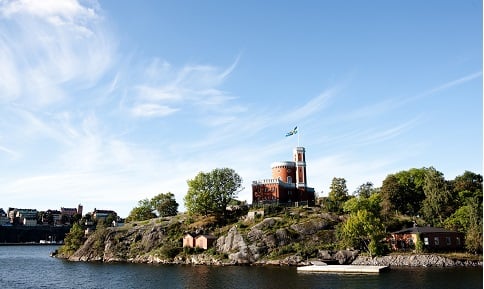The last vestiges of a long winter are behind us at last, and with Midsummer rapidly approaching, it's time for those in the area to make the most of Stockholm's undoubtedly loveliest feature – the water.
So shed your heavy winter coat, get out of that office in which you've been hibernating, and get ready to start enjoying the Swedish capital and its environs boatside!
Stockholm's large archipelago is well-known for its natural beauty. With as many as 30,000 islands, both large and small, you've got your work cut out for you this summer if you want to visit them all.
Perennial hotspot Vaxholm and party town Sandhamn are tried-and-true favourites, among Swedes and visitors alike, but Stockholm's archipelago has lots more to offer.
Whether you long for solitude on a cliff facing the tranquility of the Sea of Åland, desire a more action-packed weekend with biking or kayaking, or simply want to enjoy a delicious meal in serene surroundings, the archipelago offers plenty of options.
“You don't have to travel far to find a lovely spot in Stockholm's archipelago,” Ann-Charlotte Jönsson of the Stockholm Visitors' Board tells The Local.
The easiest way to explore the area is to find a friend with a boat. Or better still: get a hold of a boat of your own.
This will give you a chance to explore the entire archipelago, free of boat companies' schedule constraints, and find your own hidden gems.
Obviously this isn't an option for most. If you don't have a boat to hand, the next best thing may be to purchase a Island-hopping card (Båtluffskortet) from Waxholmsbolaget, and go exploring.
This card costs 420 kronor ($68). It's valid for five days, and lets you visit as many archipelago destinations as you care for in that time.
“It's perfect if you want to be able to travel around, and visit several islands,” says Jönsson about the card.
So where to go?
The areas of the archipelago closest to the mainland are also the most populous, and are easily reached with frequent boats.
The larger islands in this area tend to have well-developed infrastructure, so there's no need to feel too cut off from civilisation.
Grinda and Möja are two easily reached islands less than two hours from Stockholm, that are popular partly due to their great hiking and walking paths.
Explore the woods and fields, or visit the animals on Grinda's farmhouse, open for everyone, to get the full countryside experience! Both islands also have a number of options for spending the night.
If what you're really craving is the archipelago's top spot for a swim, you could do worse than Finnhamn.
On the island is a beautiful natural harbour popularly known as Paradise (Paradiset).
Visit it, and you'll understand why!
Finnhamn also boasts the hostel Utsikten, that's happy to rent you a boat for a mini-excursion of your own, or lend you a set of the Swedish game kubb – if you're really nice, they may even reveal the rules of the game!
If you really want a break from city life, however, you may want to reach just a little bit further out to sea.
Heading towards open sea, the archipelago suddenly shapeshifts, and the previously woody islands morph into a surreal landscape of flat, craggy rocks.
The island groups Nassa and Svenska högarna are the end of the line here.
These destinations are seriously far out, and utterly idyllic, but hard to reach unless you have access to a boat, or are willing to shell out for a boat taxi.
Two more feasible options, if you want to get closer to the edges of Stockholm's archipelago, are Rödlöga and Utö.
Rödlöga is as far out to sea as Waxholmsbolaget's boats will take you, and is a holiday option for the more adventurous among us.
This remote island has no electricity, and bringing your own tent is the only sleeping option. But with a charming little village and shimmering red granite cliffs that give the island its name, Rödlöga will win you over in no time.
Those looking for a more active way to spend their holiday should make their way over to Utö. Biking your way around this beautiful island in the southern archipelago is an unforgettable experience.
Sure, your thighs will hate you for it, but you won't regret it once you've passed by the island's 200 year-old windmill, and perhaps bought a famous “Utö loaf” at the island's tempting bakery, before reaching the delightful sandy beaches facing open sea.
Utö is one of Ann-Charlotte Jönsson's personal favourites.
“I have so many great summer memories from there,” she says.
If a no-frills trip to the archipelago doesn't appeal to you, you can always up the glamour with a visit to luxurious Oaxen Krog, and combine great sea views with world-class dining.
This critically acclaimed restaurant on the island with the same name is described by Stockholm Visitors' Board as “Sweden's number one restaurant”!
Still hard at work, and have no time for full-day excursions? Make the most of your lunch break by making for Fjäderholmarna.
These are the most easily accessible of all the islands in the archipelago.
They can be reached by boats leaving from Slussen, in the center of Stockholm, in just 15 minutes.
You'll be sharing the archipelago experience with throngs of other excited visitors, but sit a while on the sun-drenched cliffs and the world around you is sure to fade away.



 Please whitelist us to continue reading.
Please whitelist us to continue reading.
Member comments